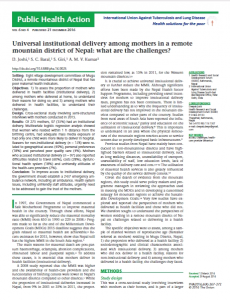
Setting: Eight village development committees of Mugu District, a remote mountainous district of Nepal that has poor maternal health indicators.
Objectives: 1) To assess the proportion of mothers who delivered in health facilities (institutional delivery); 2) among mothers who delivered at home, to understand their reasons for doing so; and 3) among mothers who delivered in health facilities, to understand their challenges.
Design: Cross-sectional study involving semi-structured interviews with mothers conducted in 2015.
Results: Of 275 mothers, 97 (35%) had an institutional delivery. Multivariate logistic regression analysis showed that women who resided within 1 h distance from the birthing centre, had adequate mass media exposure or had only one child were more likely to deliver in hospital. Reasons for non-institutional delivery (n = 178) were related to geographical access (49%), personal preferences (18%) and perceived poor quality care (4%). Mothers who accessed institutional delivery (n = 97) also reported difficulties related to travel (60%), costs (28%), dysfunctional health system (18%) and unfriendly attitudes of the health-care providers (7%).
Conclusion: To improve access to institutional delivery, the government should establish a 24/7 emergency ambulance network, including air ambulance. Health system issues, including unfriendly staff attitudes, urgently need to be addressed to gain the trust of the mothers.